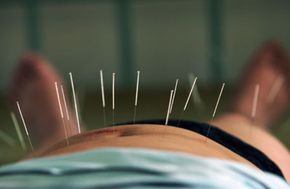Pain Management
Physicians treat pain in numerous ways. Pain management can include medications, surgery, alternative procedures (like hypnosis, acupuncture, massage therapy and biofeedback) or combinations of these approaches.
Different types of pain medications act at different places in the pain pathways. The type of medication depends upon the source of the pain, the level of discomfort and possible side effects.
Advertisement
- Non-opioid analgesics, like aspirin, acetaminophen (Tylenol), ibuprofen (Advil), and naproxen (Aleve), act at the site of pain. The damaged tissue releases enzymes that stimulate local pain receptors. Non-opioid analgesics interfere with the enzymes and reduce inflammation and pain. They can have some adverse effects in the liver and kidneys and can cause gastrointestinal discomfort and bleeding with prolonged use.
- Opioid analgesics act on synaptic transmission in various parts of the central nervous system by binding to natural opioid receptors. They inhibit ascending pathways of pain perception and activate descending pathways. Opioid analgesics are used for higher levels of pain relief -- they include morphine, meripidine (Demerol), propoxyphene (Darvon), fentanyl, oxycodone (OxyContin) and codeine. They can be easily overdosed and become addictive.
- Adjuvant analgesics (co-analgesics) are primarily used for treating some other condition, but they also relieve pain. These compounds are useful in treating neuropathic pain (chronic pain that comes from injury to the central nervous system). They include the following:
- Anti-epileptic drugs reduce membrane excitability and action potential conduction in neurons of the central nervous system. Tricyclic antidepressants affect synaptic transmission of serotonin and norepinephrine neurons in the central nervous system, thereby affecting pain-modulating pathways. Anesthetics block action potential transmission by interfering with sodium and potassium channels in nerve cell membranes. Examples include lidocaine, novocaine and benzocaine.
Surgery
In extreme cases, surgeons may have to sever pain pathways by altering areas of the brain associated with pain perception -- or performing a rhizotomy (which destroys portions of peripheral nerves) or a chordotomy (destroys ascending tracts in the spinal cord). These surgeries are usually a last resort.
Surgical interventions can be aimed at eradicating the source of the pain. For example, many people suffer back pain from herniated disks between the vertebrae. An inflamed disc can compress a nerve and cause neuropathic pain. If the patient does not respond to medication, a surgeon might try to remove at least part of the disc and relieve pressure on the nerve.
Alternative Therapy
These approaches do not involve drugs or surgery.
- Chiropracty manipulates joints to relieve compression of nerves.
- Massage stimulates blood flow, relieves muscle spasms and increases somatosensory information, which can relieve pain through the gate control theory (see previous page).
- Hot applications increase blood flow, and cold applications reduce inflammation, which contributes to pain.
- Stimulation of the skin with small electrodes can close the gate to pain.
- Acupuncture may stimulate nerve cells and release endorphins. The increased stimulation might also close the gate to pain.
- Mental control techniques rely on the ability of the mind and emotions to control and alleviate pain through descending neural pathways. They include relaxation techniques, hypnosis, biofeedback and distraction techniques.
Pain-management plans involve the participation of doctors, patients, family members and other caregivers. As with any medical treatment, the source ofpain, pain tolerance, and the potential benefits and risks of treatmen must be considered.
To learn more about pain, take a look at the links below.
Related Articles
- How Your Brain Works
- Do men and women feel pain differently?
- Why do we remember pain?
- Is all pain mental?
- Top 10 Causes of Running Pain
More Great Links
- Neuroscience For Kids: Pain
- Introduction to Chronic Pain
Sources
- American Pain Society. "Pain: Current Understanding of Assessment, Management, and Treatments."http://www.ampainsoc.org/ce/enduring.htm
- Besson, JM. "The Neurobiology of Pain." Lancet 353: 1610-1615, 1999.http://www.ub.uio.no/umn/farm/pbl/artikler/Neurobiology%20of%20pain.pdf
- Fine P, Portenoy RK. "Opioid Analgesia." McGraw Hill, 2004
- Hamilton, PS. "Michigan: Pain and Symptom Management."http://www.criticalcareceu.com/courses/151/index_ccare.html
- Hudspith, MJ et al. "Physiology of Pain."http://intl.elsevierhealth.com/e-books/pdf/1198.pdf
- Jackson, M. "Pain and Its Mysteries." Adapted from "Pain the Fifth Vital Sign," 2002.http://fleen.psych.udel.edu/articles/AEP04.3.12.PDF
- Koman, K. "The Science of Hurt." Harvard Magazine, Nov.-Dec. 2005.http://www.harvardmagazine.com/on-line/110523.html
- Krames, E. "The Neurobiology of Pain."http://pacpain.com/docs/PPTC_Neurobiology-painforweb.pdf
- Massage & Bodywork Magazine. "Making Sense of Back Pain Part One."http://www.massageandbodywork.com/Articles/JuneJuly2006/backpain.html
- Massage & Bodywork Magazine. "Making Sense of Back Pain Part Two."http://www.massageandbodywork.com/Articles/AugSep2006/backpain.html
- Massage & Bodywork Magazine. "The Pain Game Part One."http://www.massageandbodywork.com/Articles/JuneJuly2006/paingame.html
- Massage & Bodywork Magazine. "The Pain Game Part Two."http://www.massageandbodywork.com/Articles/AugSep2006/paingame.html
- McMahon, S and D Bennett. "Pain Mechanisms, Nature Reviews Neuroscience" poster.http://www.nature.com/nrn/posters/pain/nrn_pain_poster.pdf
- Nat. Acad. Sciences Colloquium. "The Neurobiology of Pain." National Academies Press, 1999.http://www.nap.edu/openbook.php?isbn=0309065488
- NCI: Pain Control. "A Guide for People with Cancer and Their Families."http://www.cancer.gov/cancertopics/paincontrol/page1
- "Neuroscience for Kids: Pain"http://faculty.washington.edu/chudler/pain.html
- NIDCR/NIH, Converging Pathways of Pain Research at NIDCR.http://history.nih.gov/exhibits/pain/index.html
- Pace, MC et al. "Neurobiology of Pain." J Cell Physiol 209: 8-12, 2006.http://www3.interscience.wiley.com/cgi-bin/fulltext/112641486/PDFSTART
- Payne, R. "Cancer Pain: Anatomy, Physiology, and Pharmacology."Cancer 63: 2266-2274, 1989.http://www3.interscience.wiley.com/cgi-bin/fulltext/112673169/PDFSTART
- Purves, D et al, "Neuroscience Chapter 10: Pain."http://www.ncbi.nlm.nih.gov/books/bv.fcgi?rid=neurosci.chapter.675#top
- Society for Neuroscience. http://www.sfn.org/
- Brain Facts. http://www.sfn.org/index.cfm?pagename=brainFacts
- Nociceptors and Pain. http://www.sfn.org/index.cfm?pagename=brainBriefings_nociceptors
- Gender and Pain. http://www.sfn.org/index.cfm?pagename=brainBriefings_Gender_and_Pain
- Neuropathic Pain. http://www.sfn.org/index.cfm?pagename=brainBriefings_neuropathic
- Killing Cells to Kill Pain. http://www.sfn.org/index.cfm?pagename=brainBriefings_killing
- CellsToKillPain Cannabinoids and Pain. http://www.sfn.org/index.cfm?
- New Targets for Pain Relief. http://www.sfn.org/index.cfm?pagename=brainBriefings_painRelief
- Spine-health.com. "Modern Theories of Chronic Pain."http://www.spine-health.com/topics/cd/pain/chronic_pain_theories/chronic_pain_theory01.html
- StopPain.org. "Introduction to Chronic Pain."http://www.healingchronicpain.org/content/introduction/default.asp
- Zichtermann, A. "Opioid Pharmacology and Considerations in Pain Management." US Pharmacisthttp://www.uspharmacist.com/index.asp?page=ce/105473/default.htm
